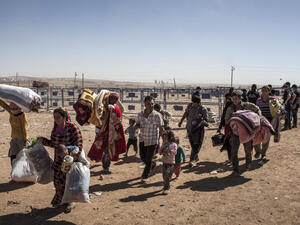Asylum applications continue to tumble in industrialized countries
Asylum applications continue to tumble in industrialized countries
GENEVA, September 6 (UNHCR) - The number of asylum applications in industrialized countries has continued to fall during the first half of 2005, maintaining the sharp downward trend that began in 2002, according to the latest figures released on Tuesday by the UN refugee agency.
Overall, the number of asylum seekers arriving in all 36 industrialized countries listed by UNHCR fell by 18 percent, compared to the same period last year (to 156,200 from 189,900), and by 35 percent compared to the same period in 2003, when 240,800 people claimed asylum.
Last year's total was already the lowest for 16 years, UNHCR said, making the latest drop in numbers even more significant. The agency has repeatedly expressed concern that the fall in numbers may reflect the considerable difficulties some refugees are facing accessing asylum systems in Europe in the face of more and more restrictive legislation and tighter border controls.
"In Europe this often heated political debate was numbers-driven in the first place," said Pirkko Kourula, Director of UNHCR's Europe Bureau. "But the debate and the restrictions seem to be continuing unabated, even though the number of asylum seekers has fallen away quite spectacularly in the industrialized countries. We wish more attention would be devoted to the huge needs that remain in other, poorer, parts of the world."
The number of new applications in the 24 European Union countries covered by the report was 112,200 - 17 percent fewer than during the first six months of 2004. The EU total is 30 percent lower than during the same period two years ago.
"The most notable change was in the 10 new EU countries, which to some extent bucked the prevailing downward trend last year," said UNHCR spokesman Ron Redmond. "However, during the first six months of this year, the numbers arriving in these 10 states fell by 34 percent compared to the same period last year."
France was the top receiving country, with 27,400 applications during the first six months of 2005. France's half-yearly totals have remained remarkably steady over the past two-and-a-half years (27,900 and 31,400 in the two semesters in 2003, and 30,000 and 28,600 in 2004). Nevertheless, the overall trend there has also been slightly downwards, Redmond noted.
The next largest receiving countries so far in 2005 are the United States with 25,400 asylum applications, down 8 percent on the same period last year; then the United Kingdom, down 23 percent to 15,500; Germany, down 29 percent to 13,300; Austria, down 26 percent to 9,200; Canada, down 26 percent to 8,700; and Sweden, down 30 percent to 8,000.
Perhaps the most dramatic decrease was recorded by the Slovakia which was down 78 percent compared to the first six months of last year. Close neighbours Poland and the Czech Republic also saw substantial decreases. However, several other "new" EU countries saw major increases, including Cyprus (up 26 percent to 4,000), Slovenia (up 38 percent to 850) and Malta (up 103 percent to 550). Among the "old" EU countries, Greece saw the biggest increase, up 101 percent to 5,500. No other "old" EU country increased by more than 10 percent.
In all, 14 of the 36 countries listed have seen their half-yearly total drop by 40 percent or more since the same period two years ago, and eight have seen their totals fall by more than half.
Serbia and Montenegro (which includes Kosovo), was the leading country of origin, with 10,800 asylum applicants during the first six months of this year. China and the Russian Federation - which includes Chechnya - came next (both with 9,400), followed by Turkey (7,100), Iraq (5,700) and Haiti (5,300).
UNHCR officials said it was not immediately clear why the number of Chechens and other Russian citizens had fallen away since they emerged as the top group of asylum seekers in 2003. By then, the big groups at the turn of the century (Kosovars, Afghans and Iraqis) had fallen away sharply following major changes on the domestic front.
"Eight of the top 10 countries of origin saw their numbers of asylum seekers fall," Redmond said, "the exceptions being the Iraqis and Haitians who went up by 31 percent and 20 percent respectively compared to the first six months of last year."
After falling away spectacularly during 2003, the number of Iraqi asylum seekers began creeping up again half way through 2004, and has remained fairly steady at just under 3,000 during the last three quarters. However the number of Iraqi asylum seekers remains far below the levels seen in 2002 when more than 50,000 claimed asylum in the 36 listed countries.
The Haitians are the only one of the top 10 nationalities to have been steadily increasing since the start of 2003. The great majority of Haitians claim asylum either in the United States - where the level has remained stable - and the French overseas territory of Guadeloupe - where the number of new applications has risen sharply.









